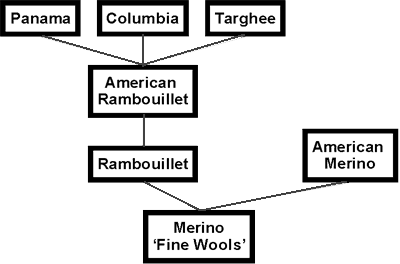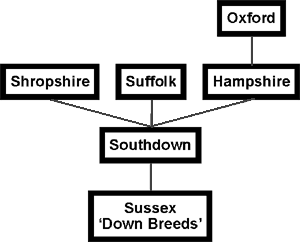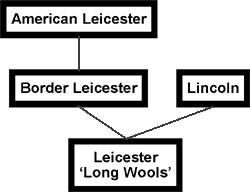("Strong flocking instinct")

flocking | feeding | fencing | protective ability | resistance to disease | psychology and chute design | psychological and social differences
Behavior Patterns, Physiology, and Psychology:
Introduction:
Sheep and goats have a unique combination of behavior patterns that directly result from physiological and psychological influences. Understanding these influences will help a producer better deal with certain behavior patterns and be able to fill the feed, water, protection, and medical needs of each animal.Flocking Instinct: Sheep and to a lesser extent goats have a gregarious instinct, which means they like to stay together. The whiteface wool type sheep express a stronger flocking instinct than do the medium wool, meat type breeds. This instinct is a very useful trait in handling sheep on open ranges. When sheep graze, they tend to spread out, but when frightened, all sheep will gather into one group. Because of this flocking instinct, a good producer knows that an animal off by itself is probably ill or has been injured.
Closely related to the flocking instinct is the instinct to follow the leader. There is an old saying "where one sheep goes, all others will follow." This tendency is used in many practical ways. Many ewes and lambs are loaded onto trucks, trailers, across bridges, and moved from one place to another by leading a sheep or goat ahead of them. Some sheep and goats are sometimes trained for the special purpose of leading other sheep or goat bands, and they may do this for many years.
Bedding Down: Sheep and goats like to lie down as night approaches and will cease their feeding during the darkened hours. They generally bed down for the night on a high place that is well drained and provides good visibility of their surroundings.
Drinking: Sheep and goats can exist without water longer than most domesticated animals. This is possibly due to the fact that they experience little water loss through perspiration. The daily water intake of a mature animal will vary from 2 to 4 gallons. Most sheep and goats seem to prefer running water to still water.
Feeding Requirements and Habits: Sheep and goats are ruminants and need bulk in their ration. Most of their diet can be met with feeds such as good quality pasture, range, or harvested forages (hay or silage). They also can consume grains for either supplemental feeding or rapid growth. Small ruminants prefer immature, short forage instead of tall, coarse growing plants. If put in a pasture or range with tall growth, they will nip the ends of the leaves off and leave the stems standing. Because of their close proximity to the ground and the fact that they have very mobile lips and sharp incisor teeth, these animals are built for grazing on short forage.
Fencing Requirements:
Fences and other corral equipment do not need to be heavy; however, the wires or boards must be tight and close enough to keep the animals from going through.Protective Ability: Sheep and goats lack the ability to defend themselves. Even those breeds with horns cannot defend themselves from certain predators. All a sheep or goat can do is either run or stand its ground. The chief enemies, particularly of sheep, are coyotes, wolves, bobcats, mountain lions, bears, feral dogs, and domestic dogs. Both ewes and rams will vigorously stomp their forefeet on the ground when attempting to scare away their enemies.
Resistance to Disease: Small ruminants do not often show signs of illness until they are very sick. A good producer should learn to recognize any deviation from the normal health of his/her animals before it is too late. The key to successful disease control is prevention and observation. The following are possible behavior signs of health problems:
Psychology and Chute Design:
When designing and constructing facilities to handle sheep and goats, it is important to understand basic animal psychology. Time spent in design can help save money and management efforts when the facility is being used. In general, it is best to do chute work early in the morning when it is cool. It is unwise to construct a chute where the animals are forced to head into the sun. It is much easier to get them to move away from the sun. A sharp but curved turn in the running chute (to prevent the animals from seeing what is ahead of them) facilitates flow-through handling. This is especially true when the producer is treating footrot in a foot bath, and/or dipping, spraying or dusting animals. A wooden floor, ramp, or deck is also useful, especially on a long ramp and chute. The beat of hooves walking on the wooden floor seems to indicate to the other animals that it is safe to proceed. See page B300 for more information on handling facilities.Psychological and Social Differences: Many social differences exist between breeds of sheep. The graphics below illustrate those breeds that can be classified as strongly gregarious, weakly gregarious, or solitary.
|
Strongly Gregarious Breeds ("Strong flocking instinct") |
 |
| Weakly Gregarious Breeds |
 |
| Solitary Breeds |
 |